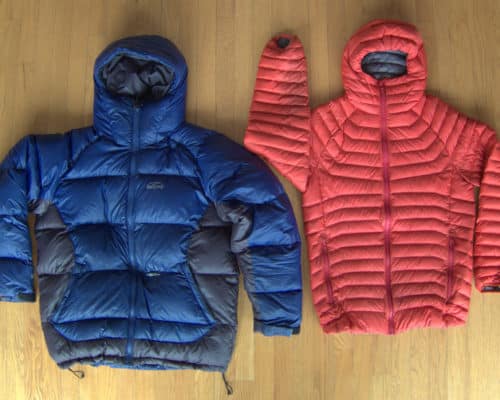Core 13 Backpacking Clothing
In the Core 13 Clothing series, I present thirteen articles of clothing that can be mixed-and-matched to create an appropriate backpacking clothing system for the full range of 3-season conditions:
- Normal daytime temps 50-90 degrees F, with extremes 10 degrees F colder and hotter
- Normal nighttime temps 30-70 degrees F, with extremes 10 degrees F colder and hotter
- Sunny or thick overcast, and everything in between
- Downpour, rain, mist, and dry
- Low, moderate, and high humidity
- Thick forest canopies, open woodlands, or big skies with relentless sun
- Intense bug pressure, mild pressure, or none
- On-trail, cross-country, and bushwhacks
If your backpacking trips are concentrated in a particular region or season, you need even fewer than thirteen items. For example, take 9 in the Colorado Rockies, and 7 for a summertime thru-hike of the Appalachian Trail.
I wrote this series to make easier the task of selecting clothing for a backpacking trip. It’s an intimidating and confusing process — there are thousands of clothing SKU’s available from hundreds of brands, with tremendous marketing hype surrounding each product. The series has been hugely popular, and has helped many readers refine their systems. I hope that it will benefit you similarly.
To read Core 13 Clothing from the beginning, start with the Introduction. If you simply want to be told what to pack, consult the capstone post, which details specific clothing systems for multiple locations in North America.
To backpack anywhere in 3-seasons conditions, how few articles of clothing are needed to mix-and-match appropriate systems? I say: thirteen — the Core 13, I’ll call the collection. However, a decent argument could be made for 11, and for a narrower range of applications or conditions, even fewer are relevant. For instance, just 9 for the Colorado Rockies and…
My Go Suit is my backpacking uniform, and I wear these clothing items every day from sunrise to sunset — and, unless they’re wet, at night too. Additional layers from my “Stop” and “Storm” categories are worn over them, while my “Sleep” layers replace them when wet for improved nighttime comfort. Out of the Core 13, a…
I learned the hard way that mosquitoes and blackflies can bite through my knit polyester and knit merino wool hiking shirts. Another lesson: A rain jacket is effective insect protection, but wearing one in the High Sierra during the middle of the day under a blazing sun is completely unbearable. A better bug strategy is a dedicated…
So long as I’m not bushwhacking, being pestered by biting insects, or needing to protect my legs from intense sun, in warmer conditions I wear shorts. But I don’t wear “hiking shorts” like the Mountain Hardwear Canyon Short or “convertible pants” like the prAna Stretch Zion Convertible Pant that can be made into shorts. Instead,…
In temperatures too cool for running shorts (less than about 50 degrees), I wear hiking pants and underwear. Probably more often, however, I wear pants only to protect my legs from brush, sun, and bugs. In these instances, the additional warmth of pants is actually a liability. Pants and underwear are Items 5 & 6 of…
In warmer months, a fleece top may offer adequate insulation for lower overnight temperatures. However, it is less thermally efficient (i.e. less warm for its weight) than down- and synthetic-insulated jackets, which I will discuss later in this series. So I do not consider fleece to be an optimal “stop” piece when backpacking. Applications Instead, I include a…
During cool camps, cold nights, and crisp mid-day rest stops, I retain my body heat with a puffy jacket containing down or synthetic insulation. If I expect nighttime temperatures below about 30 degrees, or long camps with temperatures below about 40 degrees, I will add insulated pants to my kit. Down- and synthetic-filled garments are far more thermally efficient…
In a few instances I will leave behind my rain gear, notably short backpacking trips in dry environments when there is no precipitation in the forecast, and longer trips in hot and humid environments when a soaking is actually welcomed. But otherwise I bring something to help keep me dry when it rains. A rain…
In climates with regular and long-lasting rain events, high humidity, and/or weak sunlight (due to shade, cloud-cover, or low sun angle), getting damp, wet, or even soaked seems to be an inherent part of the backpacking experience. If you wish to dry out completely during a backpacking trip in the eastern woodlands, Pacific Northwest, or Alaska, I’d recommend you find a…
With just a 13-item collection of hiking and backpacking clothing, is it possible to be comfortable here? And with that very same kit, also here? And here, too? I think it is. Earlier this month I introduced the Core 13, a tight collection of hiking and backpacking clothing that can be mixed-and-matched to create appropriate systems for every…









